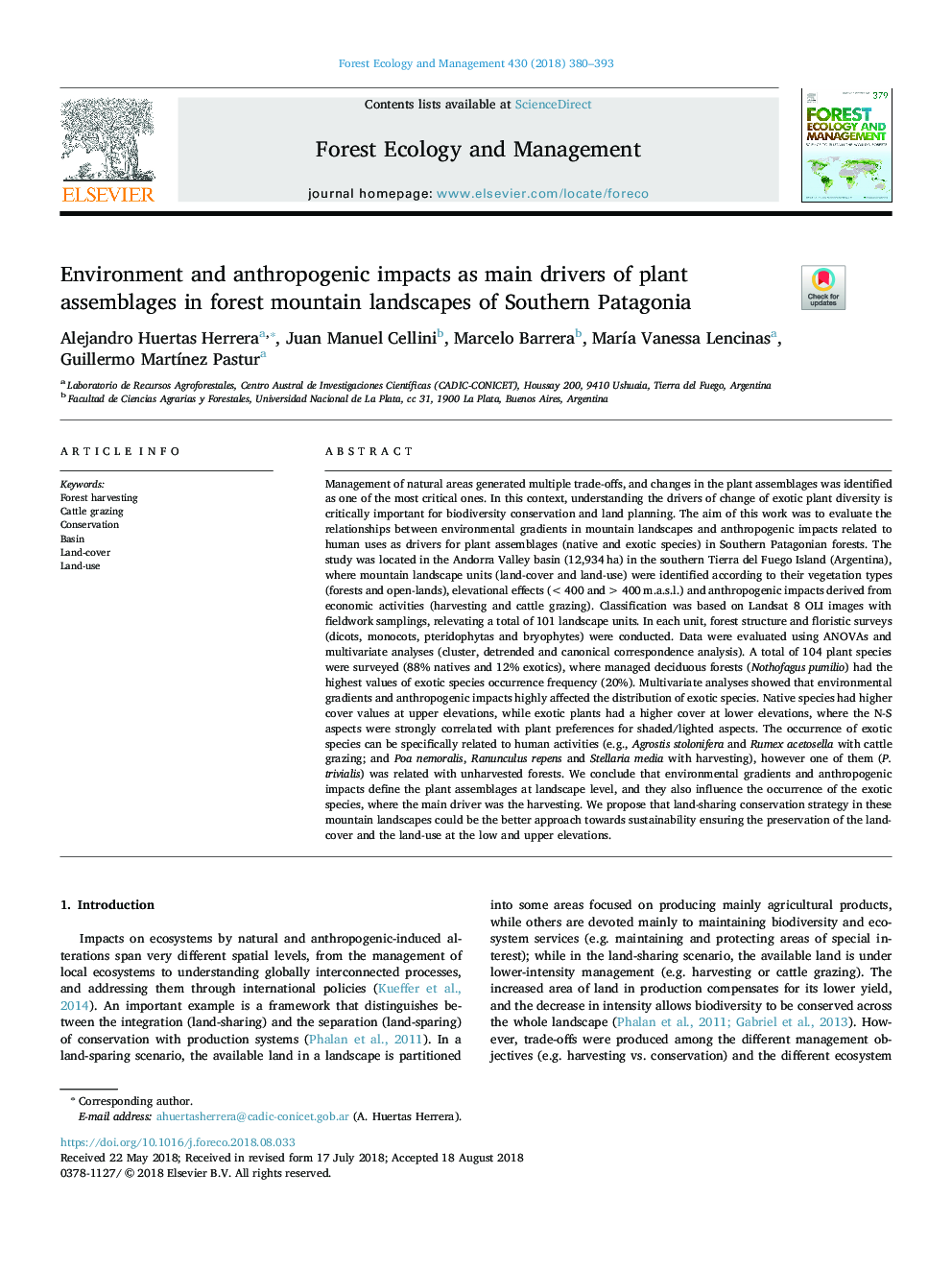| کد مقاله | کد نشریه | سال انتشار | مقاله انگلیسی | نسخه تمام متن |
|---|---|---|---|---|
| 11000033 | 1421330 | 2018 | 14 صفحه PDF | دانلود رایگان |
عنوان انگلیسی مقاله ISI
Environment and anthropogenic impacts as main drivers of plant assemblages in forest mountain landscapes of Southern Patagonia
ترجمه فارسی عنوان
محیط زیست و تاثیرات انسان شناسی به عنوان رانندگان اصلی مجموعه های گیاهان در منظرهای کوهستانی جنگل جنوب پاتاگونیا
دانلود مقاله + سفارش ترجمه
دانلود مقاله ISI انگلیسی
رایگان برای ایرانیان
کلمات کلیدی
برداشت جنگل، چرای دام، حفاظت، حوضه، پوشش زمین، استفاده از زمین،
موضوعات مرتبط
علوم زیستی و بیوفناوری
علوم کشاورزی و بیولوژیک
بوم شناسی، تکامل، رفتار و سامانه شناسی
چکیده انگلیسی
Management of natural areas generated multiple trade-offs, and changes in the plant assemblages was identified as one of the most critical ones. In this context, understanding the drivers of change of exotic plant diversity is critically important for biodiversity conservation and land planning. The aim of this work was to evaluate the relationships between environmental gradients in mountain landscapes and anthropogenic impacts related to human uses as drivers for plant assemblages (native and exotic species) in Southern Patagonian forests. The study was located in the Andorra Valley basin (12,934â¯ha) in the southern Tierra del Fuego Island (Argentina), where mountain landscape units (land-cover and land-use) were identified according to their vegetation types (forests and open-lands), elevational effects (<400 and >400â¯m.a.s.l.) and anthropogenic impacts derived from economic activities (harvesting and cattle grazing). Classification was based on Landsat 8 OLI images with fieldwork samplings, relevating a total of 101 landscape units. In each unit, forest structure and floristic surveys (dicots, monocots, pteridophytas and bryophytes) were conducted. Data were evaluated using ANOVAs and multivariate analyses (cluster, detrended and canonical correspondence analysis). A total of 104 plant species were surveyed (88% natives and 12% exotics), where managed deciduous forests (Nothofagus pumilio) had the highest values of exotic species occurrence frequency (20%). Multivariate analyses showed that environmental gradients and anthropogenic impacts highly affected the distribution of exotic species. Native species had higher cover values at upper elevations, while exotic plants had a higher cover at lower elevations, where the N-S aspects were strongly correlated with plant preferences for shaded/lighted aspects. The occurrence of exotic species can be specifically related to human activities (e.g., Agrostis stolonifera and Rumex acetosella with cattle grazing; and Poa nemoralis, Ranunculus repens and Stellaria media with harvesting), however one of them (P. trivialis) was related with unharvested forests. We conclude that environmental gradients and anthropogenic impacts define the plant assemblages at landscape level, and they also influence the occurrence of the exotic species, where the main driver was the harvesting. We propose that land-sharing conservation strategy in these mountain landscapes could be the better approach towards sustainability ensuring the preservation of the land-cover and the land-use at the low and upper elevations.
ناشر
Database: Elsevier - ScienceDirect (ساینس دایرکت)
Journal: Forest Ecology and Management - Volume 430, 15 December 2018, Pages 380-393
Journal: Forest Ecology and Management - Volume 430, 15 December 2018, Pages 380-393
نویسندگان
Alejandro Huertas Herrera, Juan Manuel Cellini, Marcelo Barrera, MarÃa Vanessa Lencinas, Guillermo MartÃnez Pastur,
